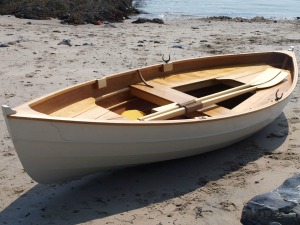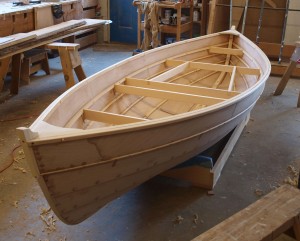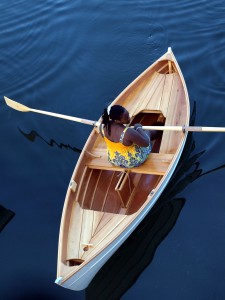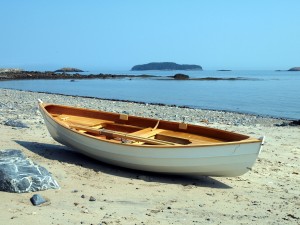
Product Specifics Section
Length over all: 12'
Waterline Length: 10' 7 1/2"
Beam: 4' 5"
Draft, board up: 0' 6"
Draft, board down: 2' 3"
Weight 85 lbs
Sail area 63 sq feet
Product Info

My aim with this design was to draw little boat that would be a pleasure to row, capable of taking a small sailing rig, and quite simple to build. Peapods are a very well-known Maine type, and although they are not as stable as boats with a transom, and don't carry the same load, they are particularly nice to row, and they certainly are pretty! The traditional peapod is often symmetrical fore and aft – the bow is the same as the stern. When I came to draw the lines, I decided to give my peapod more freeboard forward, and keep the maximum beam aft of amidships. In such a small boat, I felt that this would help to keep her dry, and improve her trim. To my eye, she looks just as nice.
I used the same construction method – glued lapstrake with plywood planking, over fore and aft stringers – that has been so successful in my Penobscot designs. To save weight, and make the boat quicker and simpler to build, I made some changes. I reduced the number of plans each side to five, simplified the structure of the sheer, and used the topmost stringer to support the seats. I feel that any small boat should be self-rescuing – in the event of a capsize, you should be able to get aboard, bail her out, and get going again without assistance. The peapod has foam flotation under the seat. This is very light, and easy to install.
As I usually do, I made a scale model of the boat before finalizing the lines. This led to a few slight modifications, and now I am very happy with the way the finished boat turned out. I think that she is very pretty indeed – I hope you agree! She certainly was a delight to build.
I usually do, I made a scale model of the boat before finalizing the lines. This led to a few slight modifications, and now I am very happy with the way the finished boat turned out. I think that she is very pretty indeed – I hope you agree! She certainly was a delight to build.
The plans include eight sheets of scale drawings, full size details, and sail and spar plans, full size patterns of the stems, station molds or building frames, centerboard, rudder and tiller, and a 75 page building manual, illustrated with over 100 drawings and photographs. The full size patterns are printed on Mylar, which does not move with changes in moisture content, making it very much more accurate than paper patterns. It also stands up much better to the rigors of workshop use, and being translucent is easy to position over your plywood or lumber. The building manual takes you in detail through each step of building, with sections on making a mast and spars, tools, materials, and a glossary of boatbuilding terms.
The two-hour DVD also takes you through every stage of building, from laying out and cutting the station molds, to putting the finishing touches on the hull, for builders who would like to actually see the job being done. You will learn about setting up, fairing, beveling and cutting gains, scribing the planking to shape, and much more. A great learning tool, and something to keep you motivated, too!
MATERIALS, COSTS, AND BUILDING TIME.
The peapod uses three sheets of 8' x 4' x 4mm marine plywood for the planking, 1 sheet of ½" plywood for the station molds, some lumber, epoxy resin, fastenings, and some hardware. Marine plywood and epoxy resin is available from Arch Davis Design. Sources for marine plywood are also listed in the building manual. Many of these firms also carry suitable lumber for other parts of the boat. Fastenings are mostly stainless steel screws, which are available from any good hardware store or lumberyard. The manual includes a full list or requirements, with advice on choosing lumber and plywood, a list of tools, and a good deal more. It should cost about $1,000 to put a peapod in the water, ready for rowing – the exact figure will vary depending on what you pay for lumber, for which there is a wide range of prices. Adding a sailing rig will almost double that, assuming that you make your own mast and spars.
Building time varies widely from one builder to another. If you have some woodworking experience, you will probably be quicker than a complete novice, but a lot depends on how you work. If you are really fussy about you joints and finish, you will spend more hours on the job. It took me about 125 hours to build the first peapod. I'm an experienced builder, but not very quick. I don't like sanding and painting, so I don't spend as long on it as others who may work to much higher standards. The peapod is a much smaller boat than the Penobscot 14, for example, and a simpler project. It's certainly a good winter's project – working weekends, you can very reasonably start one in the fall, and expect to launch in the spring.
CAN YOU DO IT?
 Many builders of the Penobscot 14 and 17 start with a little woodworking experience, and a lot of uncertainty about their projects. I always tell them that being of a practical turn of mind, and having confidence in their ability to solve problems and stick with the project, is more important than prior woodworking or boatbuilding experience. The same applies to the peapod. If you haven't built a boat before, you will be learning as you go. Remember that I am here to help, and that if you keep at it, you will get there!
Many builders of the Penobscot 14 and 17 start with a little woodworking experience, and a lot of uncertainty about their projects. I always tell them that being of a practical turn of mind, and having confidence in their ability to solve problems and stick with the project, is more important than prior woodworking or boatbuilding experience. The same applies to the peapod. If you haven't built a boat before, you will be learning as you go. Remember that I am here to help, and that if you keep at it, you will get there!
Rigging will add up to $1,600.00 to that, depending on which rig you choose.
The building time is the biggest imponderable. Everything depends on you, how much time you put in, how quick you are, how many coats of varnish you apply, and so on. A few builders finish their boats in three months. Six months is probably a realistic average, but some builders will take longer. Remember – the point is not arriving quickly, but to enjoy the journey!
WHAT YOU CAN ORDER:
STUDY PACKAGE:
This includes a 24' blueline drawing showing the lines of the boat, construction sections, interior layout, and sail plan, and a booklet containing a detailed description of the boat, its development and construction, and numerous photographs and drawings. $20.00 + P&H: ($2.50 USA, $20.00 Canada, $24.00 all other countries.)
PLANS:
Eight sheets of drawings, full size patterns, and illustrated building manual. $244.00 + P&H. Shipping Costs are given on the Order Form
VIDEO/DVD:
Two hour video/DVD shows each stage of construction. $35.00 + P&H ($6.00 USA, $20.00 Canada, $24.00 all other countries.)
FRAME KIT:
This includes the stems, beveled and marked for setting up, laminated stem facings, and station molds. The kit also includes the plans and video/DVD. $1,050.00, including plans and DVD. Please call for shipping and handling.
EPOXY KIT:
The epoxy kit comes from System Three Resins, and provides you with all the resin, hardener, additives, measuring pumps, brushes, gloves, and other items, that you will need. The System Three Epoxy Book, which gives detailed information on mixing and using epoxy, is included. (Epoxy solvent is not included, due to shipping restrictions. Hardware stores carry acetone or denatured alcohol, for use in cleaning up uncured epoxy). $310.15. Please call for shipping and handling.
PLYWOOD PACKAGE:
Plywood packages include three sheets of 4mm okoume plywood for planking, and one sheet of 12 mm plywood for the station molds. You will not need the 12 mm plywood if you start with the frame kit. They come from World Panel Products, Inc., Riviera Beach, Florida. $154.35. Please call for shipping and handling.
ALSO AVAILABLE:
Sails, rigging kits, masts, spars, and other items. Call for details.
To view detailed boat plans description and spec pages, select a link below
Penobscot 13 | Penobscot 14
| Penobscot 17 |
12 Foot Main Peapod |
Sand Dollar | Laughing Gull | Ace 14
Grace's Tender | Jiffy V-22 | Jiffy 22
| Jiffy 9-7 | Bay Pilot 18 | Jack Tar | Grace Eileen 30 | Oar Plans